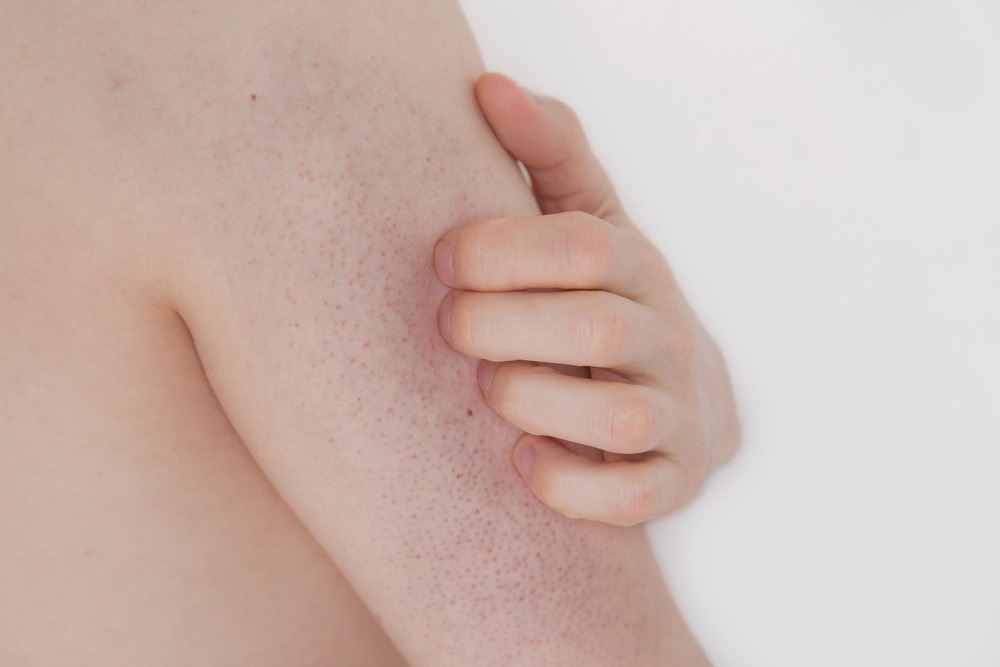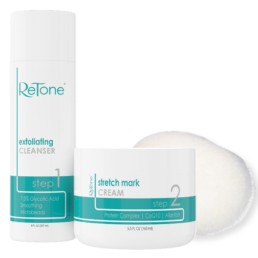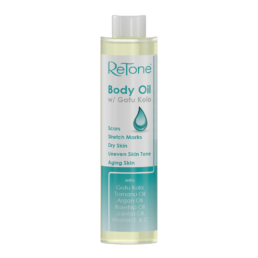Keratosis Pilaris & Diet
Keratosis Pilaris & Diet
What have you eaten today?
At a basic level, we all know that food is fuel; but do you know how your meals and snacks today have or will affect your skin?
We present this question because it’s important to remember that what you feed your body affects your entire system – including your skin.
For some individuals who live with keratosis pilaris (KP), making small tweaks or completely overhauling one’s diet for the better may prove to play a positive role in treating and successfully managing KP symptoms.
The Connection Between Keratosis Pilaris & Your Diet
The topics of keratosis pilaris and diet and keratosis pilaris and gluten are growing in discussion, but their current states remain largely based on personal experiences and dermatologist recommendations.
To date, there are no published studies that have assessed the role of nutrition in treating KP. Therefore, there is no definitive connection. However, dermatologists, medical doctors and researchers have done studies on other skin conditions that are related to KP.
From this, some medical experts believe that a poor diet or certain foods – like ones that contribute to inflammation and/or leaky gut (like gluten) – can exacerbate certain KP symptoms in some individuals, and with dietary manipulation, KP can improve.
In addition, because the skin is the body’s largest organ, a diet that fuels nutrient deficiencies, increased inflammation, hormonal imbalances, allergies, food sensitivities, and other issues, certainly has the potential to cause or intensify various skin conditions – including KP.
So, whether there is hard evidence or not about the connection between KP and one’s diet, it’s always a good idea to foster a clean diet to support vibrant, healthy skin and avoid other skin issues, like breakouts, dry skin, and others.
Important Insights on Keratosis Pilaris and Gluten
It should be noted that there are also no studies that indicate a direct correlation between keratosis pilaris and gluten ingestion, but keratosis pilaris is associated with vitamin A and essential fatty acid deficiency.
Both of these conditions can occur with impaired absorption.
With this being said, if you live with a gluten sensitivity or celiac disease, your keratosis pilaris flare-ups may be occurring if you are consuming gluten in your diet and have ongoing inflammation or malabsorption, according to Dr. Amy Burkhart, M.D., R.D..1
Types of Foods to Avoid If You Have Keratosis Pilaris, According to Medical Experts
Holistic dermatologist, Alan Dattner, M.D.,2 and internal medicine and rheumatology specialist, Dr. Erin Carter,3 recommend removing or adding the following types of food to potentially improve keratosis pilaris symptoms:
Grains
Due to some of the substances that make up most grains, like high omega 6, lectin, phytic acid, and gliadin content, grains can cause damage to one’s intestines. In some individuals, and depending on how much grain is consumed, certain issues can surface – such as leaky gut syndrome, a decrease in vitamin and mineral absorption, and an increase of inflammation throughout the body – including the skin.
It’s very common for individuals to have food sensitivities to grains – especially gluten. As noted above, many skin conditions, including KP, can be caused or aggravated by food sensitivities to grains and gluten.
Dairy
In addition to food sensitivities to grains, food sensitivities, allergies or an intolerance to casein or dairy are also very common.
For individuals with these dairy-specific conditions – especially unknowingly – consuming dairy may irritate the skin and cause irritating issues like eczema, acne, and KP flare-ups.
Sugar
While there are currently no published studies that specifically look at sugar intake and keratosis pilaris, dermatologists collect plenty of anecdotal evidence that highlights the elimination of sugars and high glycemic index foods (like grains) from a diet and the reduction of KP symptoms.
Foods to Add to Your Diet to Potentially Improve Keratosis Pilaris, According to Medical Experts
Omega 3 Foods
Omega 3 fatty acids are key to skin health. Omega 3 supplementation has been found to help treat acne, psoriasis, eczema and a number of other health conditions. Eating foods high in omega 3 fatty acids can also help with this and help balance and calm inflammation caused by certain foods.
Grassfed beef, wild fish, and pasture raised eggs are all great sources of omega 3 foods.
Foods High in Vitamin A and D
Because both of these essential vitamins encourage healthy skin cell production, foods such as salmon, hard-boiled eggs, sweet potatoes, carrots, kale, mushrooms, and more will benefit the skin and potentially reduce KP symptoms.
Additionally, there is some evidence that vitamin A deficiency can cause Phrynoderma – a skin condition that is related to KP and involves keratin.
Vitamin D deficiency is linked to acne and many tie-in KP symptoms.
Foods High in Vitamin E
Vitamin E has shown to be effective at treating atopic dermatitis and can help protect the skin against sun damage by acting as an antioxidant. Healthy foods that are high in vitamin E and may reduce KP symptoms include almonds, hazelnuts, green leafy vegetables, and more.
Before Making Changes to Your Diet, Consult with Your Doctor
The information above must not be taken as an alternative to medical advice from your doctor or other health care provider. Before making any changes to your diet or vitamin intake – or if you have specific questions about a skin or medical matter – consult with your doctor first.
Exfoliating Skincare with Hydration is STILL the Mainstay of KP Treatment
For most individuals living with keratosis pilaris, eating different foods that benefit the skin (and removing others that don’t) may very well have the potential to improve KP symptoms. A transformative diet, however, probably won’t be enough for everyone.
While keratosis pilaris is certainly a frustrating skin condition, KP-prone skin can improve by preventing certain symptoms from returning with the addition of a specific, KP-focused skincare approach.
Keratosis pilaris treatment must be a two-step process – first, to soften and remove dead skin cells and, second, to prevent additional dead skin and future plugged follicles through superior hydration.
While there is an abundance of over-the-counter KP creams, as well as other dermatologic therapies – such as steroids, alpha-hydroxy creams, retinoic acid therapies and others – treating KP doesn’t have to be chemical-heavy, expensive, or a guessing game as to whether a certain treatment will work or not.
There is an easy, straightforward approach:
Pair a Proper Diet with a Smart Skincare Routine: Discover ReTone’s 2-Step Keratosis Pilaris Therapy
Unlike other KP therapies, ReTone’s breakthrough home treatment tackles both exfoliation and moisturization in one, all-encompassing kit.
Uniting only naturally occurring, yet incredibly impactful ingredients that reduce and
prevent the signature marks of keratosis pilaris, our KP treatment will help your skin
start to feel anew and appear smoother, softer and more supple.
Since KP is a common, albeit frustrating, genetic skin condition, there is no definitive
cure. The ReTone formula, however, was created for daily use to stop the buildup of
keratin in the hair follicle and prevent the formation of rough, hard plugs that are the
culprits of the dry, bumpy, inflamed, red look.
Discover ReTone’s Keratosis Pilaris Essentials and try worry-free with our money-back guarantee:
Resources:
1 Amy Burkhart M.D., R.D. Gluten Causes Keratosis Pilaris (a.k.a. “Chicken Skin”): Fact or Myth? Accessed August 6, 2019. https://theceliacmd.com/articles/gluten-and-keratosis-pilaris-chicken-skin/.
2 Mind Body Green. How to Treat Keratosis Pilaris With Simple Diet Changes & Natural Skin Care Products. Accessed August 6, 2019. https://www.mindbodygreen.com/articles/how-to-treat-keratosis-pilaris-naturally.
3 Pure and Simple Nourishment. How to Heal Keratosis Pilaris with Diet. Accessed August 6, 2019. https://www.pureandsimplenourishment.com/how-to-heal-keratosis-pilaris-with-diet/.
Keratosis Pilaris & Dry Skin
Keratosis Pilaris & Dry Skin
Tightness, itchiness, redness, flakiness and dull-looking skin – if your skin could send a true SOS, these symptoms would be the hallmarks of the message.
While dry skin is common and, depending on the season, to be expected, it’s an irritation that can make other skin conditions – like keratosis pilaris – worse.
Keratosis Pilaris Itchy Symptoms
Simply put, an individual with dry skin is, unfortunately, more likely to have keratosis pilaris.
As you – or anyone living with KP – well know, the dry, rough patches and tiny bumps on your upper arms, thighs and cheeks generally don’t hurt or itch, the presence of dry skin can exacerbate KP symptoms and aggravate your outer dermis.
With severe dry skin and/or more pronounced keratosis pilaris (where the bumps get inflamed) some individuals may experience severe itching.
While there is no cure for keratosis pilaris, there are remedies and treatments that can significantly diminish the itchy symptoms and soothe keratosis pilaris dry skin.
7 Ways to Treat Keratosis Pilaris Dry Skin


KP is a benign skin condition that forms from the buildup of a protein in the hair pores called keratin. The keratin gets clogged in the pores and, therefore, blocks the opening of growing hair follicles. In turn, small bumps form over where a body hair should be.
While KP is known to clear up with age, it’s understandable if you don’t want to wait until you reach the coveted age to live with comfortable dermis and feel confident in your skin.
There are effective steps and treatment routes you can take now to alleviate your irritations and keratosis pilaris dry skin:
Simple steps to start with:
- Avoid wearing tight clothes. Clothes that are tight to the skin – especially in warmer weather – can produce friction and irritate already aggravated, dry skin.
- Add a humidifier to your home. By adding moisture to the air in any room, you can help your skin maintain moisture and prevent itchy, KP flare-ups.
- Take short, warm baths. Soaking in warm water for a short amount of time can help unclog and loosen pores. From there, you can more effectively exfoliate. Note that a short bath is key, as prolonged time in water can remove the body’s natural oils.
- Exfoliate daily. Gentle exfoliation on a daily basis can remove overgrowth of dead skin, soften and rejuvenate dry dermis, and improve the overall appearance of KP-prone skin.
Consider a treatment route:
Medications.
Topical medications, like steroids and anti-inflammatories, can reduce inflammation or aid in skin tissue growth and repair.
Medications aren’t for everyone and they can have adverse effects. A dermatologist should have the overall call as to whether your skin conditions would completely benefit from medications, or if another route would be just as successful and less chemically-based.
Dermatological treatments.
Depending on the severity of your itchy, dry skin and keratosis rash, a skin doctor may recommend a chemical peel or a retinol cream.
Chemical peels essentially remove the outer layer of your skin to initiate the removal of old skin cells. Peels can have undesired side effects, however, such as excessive skin irritation, breakouts, and an increased sensitivity to UV (sun) light. Your doctor can discuss this method in more detail, including the pros and cons.
Retinol creams help promote cell turnover and, thus, help smooth keratosis pilaris skin. There are a number of documented risks to using retinol that are similar to those of chemical peels. Retinol use is also not recommended during pregnancy.
All-encompassing lotions or treatment kits.
Through innovation and continuous research to understand KP (and accompanying dry skin), there are keratosis pilaris moisturizers and products that deliver an entire spectrum of support, relief and results.
If you live with KP and suffer from dry skin, keratosis pilaris moisturizers that foster anti-itch properties and boast a superior ability to hold on to water molecules to help keep skin moist will take your skin to new heights.
Certain products will also help you achieve skin with reduced redness and irritation.
Take Precautions with Keratosis Pilaris Moisturizer Ingredients
Some keratosis pilaris moisturizers push results by including ingredients that may deliver certain, desired outcomes, but produce negative, undesired side effects, such as:
- Stinging
- Redness
- Irritation
- Dryness
Achieve Incredible Dry Skin Relief and Reduce the Appearance of Your Keratosis Pilaris Bumps & Scars
Living with KP and dry skin is no simple feat. Days are filled with rough, itchy skin and, sometimes, an insecurity in your own skin.
Understanding your struggle to find a product that works and is safe is what drove us to develop our breakthrough exfoliating body cleanser to relieve itchy KP skin and tackle dry, tight, dull-looking skin.
In addition to fighting your most prevalent skin conditions, this exfoliating body cleanser will work to prevent and significantly reduce the appearance of wrinkles and dark spots, such as stretch marks and scars. Overall, you’ll notice an improvement in your skin’s texture, clarity, firmness and elasticity.
Give it a try risk free and begin to see results you can be proud of in as little as 60 days.
Keratosis Pilaris & Scars
Keratosis Pilaris & Scars
Bumpy skin that usually displays uninvited red, rough patches and scars – be gone!
Even as a harmless, common skin condition, keratosis pilaris is anything but simple and easy to tackle.
As someone who rises and shines every single day with keratosis pilaris – or, as KP is commonly dubbed: chicken skin, gooseflesh, or sandpaper skin – you’re not alone if you’re at the end of your rope with what skincare routine or treatment to try next in the hopes that it will work better than the one before.
Does Keratosis Pilaris Cause Scarring?
The short answer is: Yes.
Searching for the next best KP solution is, understandably, top of mind if keratosis pilaris scars have formed on your arms, legs, and cheeks.
In the majority of keratosis pilaris scarring cases, the scars are, unfortunately, caused when you pick at the bumps. From all the picking, the bumps can become infected without you even realizing it and, as a result, keratosis pilaris scars form.
Needless to say, to prevent keratosis pilaris scars, it’s as simple and as hard as not picking the bumps on your skin.
Will KP Scars on Arms, Legs & Other Areas Ever Go Away?
We want to stress that even if you’ve picked at your KP bumps for years and, therefore, have several KP scars on your arms, legs and other areas, there are various methods that can prove successful in reducing the appearance of your KP scars.
But will they ever go away entirely? It simply depends.
As you review each route below, remember that each solution is only as effective as you make it. By making your chosen route a regular part of your skin care regime, time and consistent use can prove to be a very effective way to fade keratosis pilaris scars.
How to Fade Keratosis Pilaris Scars: 3 Possible Routes
Laser Therapy
A medical procedure that uses focused light therapy (lasers) to sear off skin bumps and either remove the outer layer of the skin’s surface or stimulate the production of new skin cells to cover damaged cells and scars.
Downside: Can be expensive, painful and doesn’t always yield successful results.
Chemical-Based Exfoliants
Chemical peels and exfoliants usually contain alpha-hydroxy acids (among other ingredients) that moisturize damaged, scarred skin while simultaneously initiating the removal of old skin cells. Essentially, this process removes the outer layer of dead skin cells, helping scars to fade.
Downside: Can have undesired side effects, such as excessive skin irritation, breakouts, and an increased sensitivity to UV (sun) light.
Certain Creams and Body Oils
With so many KP creams, lotions and body oils on the market, only the most powerful, comprehensive products will approach KP and its accompanying scars in a different, effective manner.
Because the real damage of keratosis pilaris scars is under the skin’s surface, the best KP creams and body oils that help to significantly reduce the appearance of scars must safely and deeply penetrate the skin and target the damaged skin tissue to support the regeneration of beautiful, healthy skin.
Downside: Can take longer than desired – approximately 60 days – to see real, long-lasting results. However, as the safest route, most individuals who live with KP prefer this solution over any other.
A Revolutionary Way to Reduce the Appearance of Keratosis Pilaris Scars
Beautiful Skin with KP is More than Possible
Here to prove you don’t need to go the expensive medical treatment route or put your skin through a chemical peel to reduce the appearance of KP scars, ReTone’s powerful products offer a simple and affordable way to tackle your KP scars.
ReTone combines powerful, key ingredients to:
- Significantly reduce the size, color and appearance of keratosis pilaris scars
- Support collagen and elastin production for thicker, less translucent skin that fosters a more even, younger-looking appearance
- Hydrate and rejuvenate surrounding skin
Delivering results men and women can see, ReTone users typically see results in as little as 60 days.
Remove stubborn, unwanted KP scars with a cream or body oil that is proven to prevent or reduce marks and scars of all shapes and sizes, and from any occurrence – from keratosis pilaris to pregnancy.
Try our Scar and Stretch Mark Therapy Kit or our Body Oil for marks and scars risk free:







